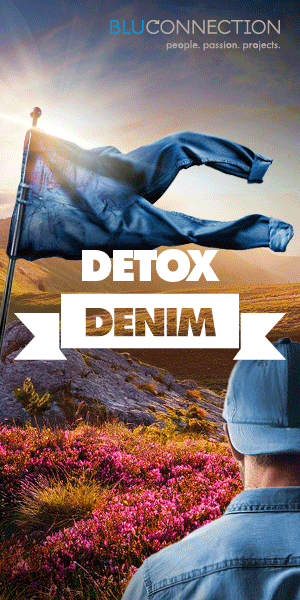“We are watching EU regulations carefully”

From an update to its matte offering, to partnering for circularity and helping brands address the upcoming European Union legislation, Lenzing’s head of global business development for denim, Tuncay Kiliçkan, explains how the Austrian fibre company is keeping one step ahead.
Can you start by telling us about the new Matte Tencel Denim collection, how it came about and what the benefits are?
Two years ago, we launched matte Tencel fibres. The first applications were lightweight fabrics in the pure Tencel compositions. We carried on our research in how to benefit from this fibre and found the difference between the standard Tencel lyocell and its matte variant is more pronounced if you use more bottom-weight fabrics or coarser constructions, for instance in the 12oz range, regardless of the fabric construction. Even 50%-plus Tencel-containing fabrics look just like cotton in terms of sheen. There is no synthetic feel in the fabric, which made us excited, so we explored more.
We discovered that even if you use 40%-plus matte Tencel fibres in the fabric, it gets the softness, which is important to the end user, but optically the fabric doesn’t become shiny, rather it looks much more cotton-like and therefore suited to “authentic” denim or menswear styles. Having the natural look and a soft hand feel is a double win, especially combining it with Lenzing’s closed-loop production, which offers a circular and sustainable back story.
The high percentage of Tencel also addresses the issues of cotton. In 2022, cotton’s price doubled in a year, which made things very difficult. Add this to the harvest fluctuations – it’s difficult to know what volumes will be available in the future – and there always needs to be a Plan B, for instance, replacing some of the cotton.
How does the addition of Tencel affect the dyeing, or the finishing or fading?
In terms of finishing, Tencel reacts better with laser as it is whiter, so the contrast is nicer. All the other dyeing and finishing processes are the same. This makes Tencel a great alternative to cotton. Especially with our new product, we can achieve authentic denim looks. Sometimes initiatives like this are small-scale, high-price launches, but our collaboration has been made with 15 mill partners - in Turkey, Bangladesh, Pakistan, Vietnam, China etc - so if brand partners like the product, it’s not specific to a certain area or a certain price level.
Looking at the sustainability story behind adding a higher percentage of Tencel, do you think brands might be able to market that to consumers, or are we not there yet?
I think we’re not there yet. Many people are turning to organic cotton but the supply is limited. ‘Organic’ as a claim is the most well-known by consumers. If you asked a consumer about closed-loop production, I don’t think they’d know what it is. With Tencel, brands understand the sustainable background, which makes it easier to convince designers to use more Tencel, especially now, as there are no limits in terms of it being shiny.
Lenzing has joined several collaborations and projects that are assessing circularity – for instance Accelerating Circularity and the Circular and Sustainable Textiles and Clothing consortium – why is this issue so important for Lenzing, and what have you learned from these partnerships?
Circularity is so important because the textile industry is creating a lot of waste, and waste could be someone else’s treasure. As an industry, we are also trying to consume fewer raw materials. It’s our job as Lenzing to move towards a circular model as that will be helpful for everyone.
Mechanical recycling is creating a solution but there are limits: it’s very difficult to exceed 20% recycled cotton because you have issues with the durability. If you use chemical recycling methods, there is almost no difference in terms of the performance of the fibre. For instance, if our partners swapped from Tencel lyocell to Tencel lyocell with Refibra technology, which is made of up to 30% recycled pulp from pre- and post-consumer cotton textile waste, there is no issue.
Chemical recycling is a great asset, and we’re trying to push the industry towards that because if you want to address the big picture - the amount of waste textiles that are produced - you can only do this by working together. The brands need to consider the EU’s Extended Producer Responsibility regulation [whereby a producer's responsibility is extended to the post-consumer stage of a product's life cycle], we can be part of that solution. We are working with Swedish forestry cooperative Södra and with Renewcell to offer solutions that are scalable.
Technology-wise, the recycled content within our Refibra technology could be increased from 30% to 50%, but then the volumes of the fibre we could produce would be less. It is not only a question of the volume of the textile waste but also the quality because lyocell manufacturing is so precise. It uses almost zero chemicals, it’s like a thermophysical production process. If we had 100% cotton waste or 100% lyocell waste, we could make lyocell fibre with solely recycled content, but blends like polyester or viscose cause issues.
You mentioned Extended Producer Responsibility. With the new EU regulations coming in, is that part of the thinking? The brands will have to start changing so you will be ready to offer these solutions?
We are watching these regulations carefully and have a team dedicated to this. There are many different pillars, such as claims, product performance and lifecycle assessments, we are paying attention to all of them. Where we can be a solution maker for brands is extended product responsibility: what are they going to do with their waste?
There are ways to reuse that – chemical and physical – we could be a great partner in the chemically recycled area, with our other partners. For instance, in Austria, Södra is working with two companies – one is collecting the waste, the other is sorting it – Södra is then making a pulp and we are making a fibre. Lenzing and Södra are working on similar recycling projects and that collaboration has backing from the European Union. We want to be a solution-maker for our brand partners.
In terms of the claims, the new legislation says that durability is very important. That might also be why not everyone is crazy about increasing the amount of mechanically recycled cotton in their denims. They don’t want to diminish the tensile or tear strength. We are keeping a close eye on these developments, people will need to be prepared.
Looking at claims, how will Lenzing’s new ocean tracker help the manufacturers or brands?
Lenzing has several sites around the world – the US, UK, China, Czech Republic – some are pulp producers, some are fibre sites. For instance, our US site supplies to Latin American textile producers and our Nanjing unit supplies to the Chinese textile producers. So, this tracker gives them the assurance that they’re using our fibres and it is secure. The mapping offers traceability, so they can see exactly where it’s coming from, and helps them calculate the carbon footprint as well. It’s a way of making the complicated textile production route a bit clearer.
What are the issues you’re working on that you feel will be most important in the future? What are your customers asking for?
Everybody is talking about the price and availability of cotton as very problematic. Even the Textile Exchange said man-made cellulosic fibres are 6% of the global fibre portfolio but this will be almost doubled by 2030. That’s why we’re seeing a lot of investments in China, India and Turkey, so we are keeping our leadership on that by partnering with our mill partners and brands, to give them guidance on the EU legislations and keep flying our sustainability flag.
We are also going to show them the benefits of using Tencel at a B2C [consumer] level. If they use branded ingredients, they will have the benefits of recognition – consumers recognise the Lenzing fibres or Tencel on the hangtags.
We also believe in good partnerships. For instance, if you want to chemically recycle, you have to partner with many companies including start-ups, machinery companies and software companies. In five or 10 years, things will change a lot and we will work hard to be part of that.
One of the dilemmas in sustainability is still the cost; we cannot charge extra for the sustainable part, some people will always go for the cheapest option. We need to come up with the solutions and pass the message clearly to the end user. That’s a challenge that we are working on.
In terms of what Lenzing is working on internally, we are converting our sites to biomass, wind or solar energy, reducing our carbon footprint. We are ahead of our plans. We are trying to use more recycled pulp; so, there are many things working side by side.













